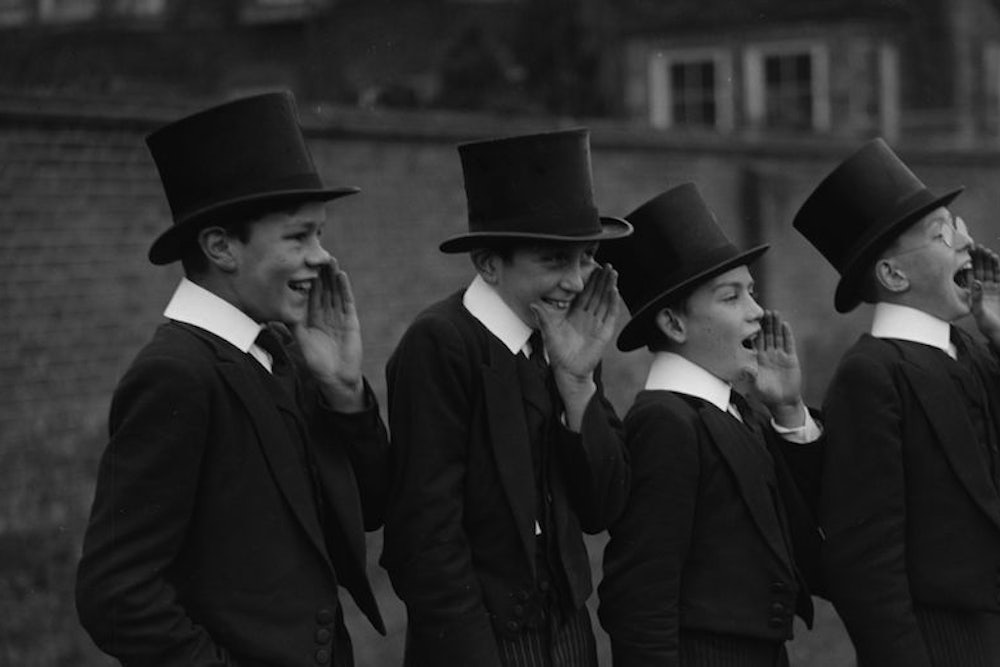When a royal servant blabbed ten years ago that Prince Charles had carried on a gay affair, the American press jumped at the chance to riff on the supposedly high rates of gay experimentation among British men. Stephen Colbert, as usual, had the best explanation. “It’s not gay Jon, it’s aristocratic. It’s a different culture,” he quipped. “What’s different about it?” asked Stewart. “Mainly how gay it is,” Colbert replied.
This sketch doesn't just make us nostalgic for the days when you could watch Stewart and Colbert in the same half-hour; it also typifies a stereotype about British culture. All-boys’ boarding schools are thought to lend themselves to teenage experimentation. Gay storylines and cross-dressing feature heavily in British literature and pop culture, from Shakespeare and Dickens to Brideshead Revisited, The History Boys, and Blackadder.
But is it more than just a stereotype? A new paper in the journal Men and Masculinities suggests that 93 percent of straight young British men have spooned with another man, and a full 98 percent have shared a bed with a guy. Two British sociologists, Eric Anderson of the University of Winchester and Mark McCormack of Durham University, investigated young British men’s views on the boundaries of same-sex friendships by interviewing 40 straight male undergraduate students, recruited from Anderson’s sociology of sports class. It turned out that the students had pretty liberal attitudes toward same-sex touching. Of the 40 students Anderson and McCormack spoke to, 37 reported that they had at some point “cuddled with another male.” (The authors helpfully define cuddling as “gentle physical contact for a prolonged period of time.”) Two students, Jarrett and Max, show just how casual their attitude toward cuddling with other dudes is:
Without being prompted, Jarrett repeatedly stressed the amount of cuddling he and his mates engage in. ‘‘We’re always cuddling, my lot. We’re all comfortable with each other.’’ Others highlight that cuddling occurs during the day and will often be described as ‘‘a quick cuddle.’’ John praised these short interactions, saying ‘‘I love a quick cuddle, just so you remember your friends are about and are there for you.’’
Max described how he and his friends would nurse their hangovers together:
On the morning following a night out clubbing, the friends will congregate at one house, where they watch TV, play video games. … These activities would include frequent cuddling, which Max described as ‘‘feeling good,’’ adding, ‘‘If your mate has a headache you can like massage his head, or you just lie there together holding each other and laughing about how awful you feel.’’
39 out of the 40 students also said they’d slept in a bed with another guy at least once since starting college. Some cited practical reasons like accommodating a friend who’d come to visit a cramped dorm or crashing at a friend’s house after a night out, but others said they just wanted to feel close to their “mates.” For the most part, they saw it as no big deal: “Most indicated that it was not necessary to be close friends to share a bed with someone. … These men are able to share beds with other men without risking their socially perceived heterosexual identity,” wrote Anderson and McCormack.
It's hard to define a norm when it comes to “homosociality”—the word sociologists use for intimate same-sex behavior that is not romantic. American psychiatrist Fritz Klein, write Anderson and McCormack, believed that straight guys avoid physical intimacy with other men because of “a myth that such intimacies are inspired by sexual desire and are thus precursors to sexual intimacy.” Sociologist David Plummer also thought homophobia was responsible for the taboo on same-sex touching: “Homoeroticism is … excised from same-sex interactions through homophobic stigma, leaving little but physical violence and particular ritualized sporting activities as outlets for male same-sex touch.”
Of course, a sample of 40 students can’t really prove anything, especially when that sample consists entirely of white 18- and 19-year-olds, most of whom identify as middle-class. And especially when there's no cross-cultural comparison. Got that, sociologists? We need more research. These are pressing questions.
